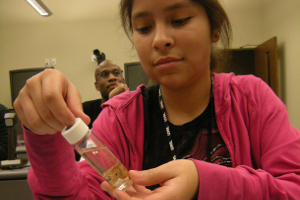Instructions
How to Play the Game:
- From the DVD, print a copy of the game sheet and this instruction sheet for each person.
- Divide into a maximum of four teams and decide which team will go first. Each player on a team uses his own “Did You See That?” game sheet.
- Each player places a coin or other small object on the “Start” space for any of the paths. (All paths are the same length.)
- Begin the DVD and click “Play Game.”
- When the first question appears, team one will have 15 seconds to answer. (One answer only.)
If the answer is correct, each player on that team moves his playing piece the number of spaces allotted for the question.
The video will continue playing, and the turn moves to the next team. The object of the game is to answer enough questions
correctly to get your playing piece to the end of the path, where you will need only one more correct answer to move ahead into
the public health laboratory career of your choice!
To Win: The team or player who has advanced the farthest along a pathway by the time the video has ended, or is the first to reach a career at the end of the path, wins the game.
About the Public Health Laboratory
The focus of public health is just what it sounds like: protecting the health of the public. While local healthcare practitioners (like your family doctor) are concerned with one individual at a time, public health professionals look at the broader picture. They detect trends and outbreaks in the community and take measures to control the danger and thereby protect the public.
Careers in public health can vary from the common to the unexpected, from the identification of unusual organisms to environmental testing to biosecurity…and from engineering to disease surveillance and even to journalism and education. With the public health field expanding its scope into new sciences and partnerships, the Association of Schools of Public Health estimates that by the year 2020, an additional 250,000 public health workers will be needed in the United States.
This game is about life inside a public health laboratory. These laboratories are a vital part of the public health system, with at least one in each of the 50 states. Public health labs provide specialized testing that’s unavailable to local laboratories. They also serve as the contact between local facilities and national agencies like the U.S. Centers for Disease Control and Prevention (CDC). During bioterrorism and chemical terrorism events, public health labs move into action, along with their state and federal partners in emergency response, to identify and contain the danger.
As you watch the videos and listen to the stories told by personnel from our public health laboratory, we hope you will be inspired to add public health laboratory scientist to your list of career possibilities.
Want More Information?
The following websites offer more information about careers in public health and the clinical laboratory:
- Association of Public Health Laboratories: www.aphl.org
- Labs Are Vital: www.labsarevital.com
- To search for Medical Laboratory Technician (MLT) and Medical Technologist (MT) schools by state, go to www.naacls.org and select “Find a Program,” or go to this link.



